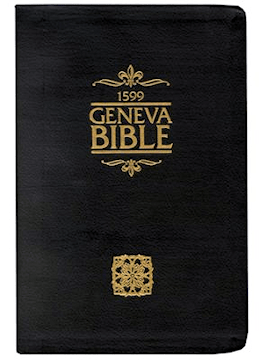Textus Receptus Bibles
Geneva Bible 1560/1599
| 3:1 | These also were the sonnes of Dauid which were borne vnto him in Hebron: the eldest Amnon of Ahinoam, the Izraelitesse: the seconde Daniel of Abigail the Carmelitesse: |
| 3:2 | The third Absalom the sonne of Maachah daughter of Talmai King of Geshur: the fourth Adoniiah the sonne of Haggith: |
| 3:3 | The fift Shepatiah of Abital: ye sixt Ithream by Eglah his wife. |
| 3:4 | These sixe were borne vnto him in Hebron: and there hee reigned seuen yeere and sixe moneths: and in Ierusalem he reigned three and thirtie yeere. |
| 3:5 | And these foure were borne vnto him in Ierusalem, Shimea, and Shobab, and Nathan, and Salomon of Bathshua the daughter of Ammiel: |
| 3:6 | Ibhar also, and Elishama, and Eliphalet, |
| 3:7 | And Nogah, and Nepheg, and Iaphia, |
| 3:8 | And Elishama, and Eliada, and Eliphelet, nine in nomber. |
| 3:9 | These are all the sonnes of Dauid, besides the sonnes of the concubines, and Thamar their sister. |
| 3:10 | And Salomons sonne was Rehoboam, whose sonne was Abiah, and Asa his sonne, and Iehoshaphat his sonne, |
| 3:11 | And Ioram his sonne, and Ahaziah his sonne, and Ioash his sonne, |
| 3:12 | And Amaziah his sonne, and Azariah his sonne, and Iotham his sonne, |
| 3:13 | And Ahaz his sonne, and Hezekiah his sonne, and Manasseh his sonne, |
| 3:14 | And Amon his sonne, and Iosiah his sonne. |
| 3:15 | And of the sonnes of Iosiah, the eldest was Iohanan, the second Iehoiakim, the thirde Zedekiah, and the fourth Shallum. |
| 3:16 | And the sonnes of Iehoiakim were Ieconiah his sonne, and Zedekiah his sonne. |
| 3:17 | And the sonnes of Ieconiah, Assir and Shealtiel his sonne: |
| 3:18 | Malchiram also and Pedaiah, and Shenazar, Iecamiah, Hoshama, and Nedabiah. |
| 3:19 | And the sonnes of Pedaiah were Zerubbabel, and Shimei: and the sonnes of Zerubbabel were Meshullam, and Hananiah, and Shelomith their sister, |
| 3:20 | And Hashubah, and Ohel, and Berechiah, and Hazadiah, and Iushabheshed, fiue in nomber. |
| 3:21 | And the sonnes of Hananiah were Pelatiah, and Iesaiah: the sonnes of Rephaiah, the sonnes of Arnan, the sonnes of Obadiah, the sonnes of Shechaniah. |
| 3:22 | And the sonne of Shechaniah was Shemaiah: and the sonnes of Shemaiah were Hattush and Igeal, and Bariah, and Neariah, and Shaphat, sixe. |
| 3:23 | And the sonnes of Neariah were Elioenai, and Hezekiiah, and Azrikam, three. |
| 3:24 | And the sonnes of Elioenai were Hodaiah, and Eliashib, and Pelaiah, and Akkub, and Iohanan, and Delaiah, and Anani, seuen. |

Geneva Bible 1560/1599
The Geneva Bible is one of the most influential and historically significant translations of the Bible into English, preceding the King James translation by 51 years. It was the primary Bible of 16th century Protestantism and was the Bible used by William Shakespeare, Oliver Cromwell, John Knox, John Donne, and John Bunyan. The language of the Geneva Bible was more forceful and vigorous and because of this, most readers strongly preferred this version at the time.
The Geneva Bible was produced by a group of English scholars who, fleeing from the reign of Queen Mary, had found refuge in Switzerland. During the reign of Queen Mary, no Bibles were printed in England, the English Bible was no longer used in churches and English Bibles already in churches were removed and burned. Mary was determined to return Britain to Roman Catholicism.
The first English Protestant to die during Mary's turbulent reign was John Rogers in 1555, who had been the editor of the Matthews Bible. At this time, hundreds of Protestants left England and headed for Geneva, a city which under the leadership of Calvin, had become the intellectual and spiritual capital of European Protestants.
One of these exiles was William Whittingham, a fellow of Christ Church at Oxford University, who had been a diplomat, a courtier, was much traveled and skilled in many languages including Greek and Hebrew. He eventually succeeded John Knox as the minister of the English congregation in Geneva. Whittingham went on to publish the 1560 Geneva Bible.
This version is significant because, it came with a variety of scriptural study guides and aids, which included verse citations that allow the reader to cross-reference one verse with numerous relevant verses in the rest of the Bible, introductions to each book of the Bible that acted to summarize all of the material that each book would cover, maps, tables, woodcut illustrations, indices, as well as other included features, all of which would eventually lead to the reputation of the Geneva Bible as history's very first study Bible.